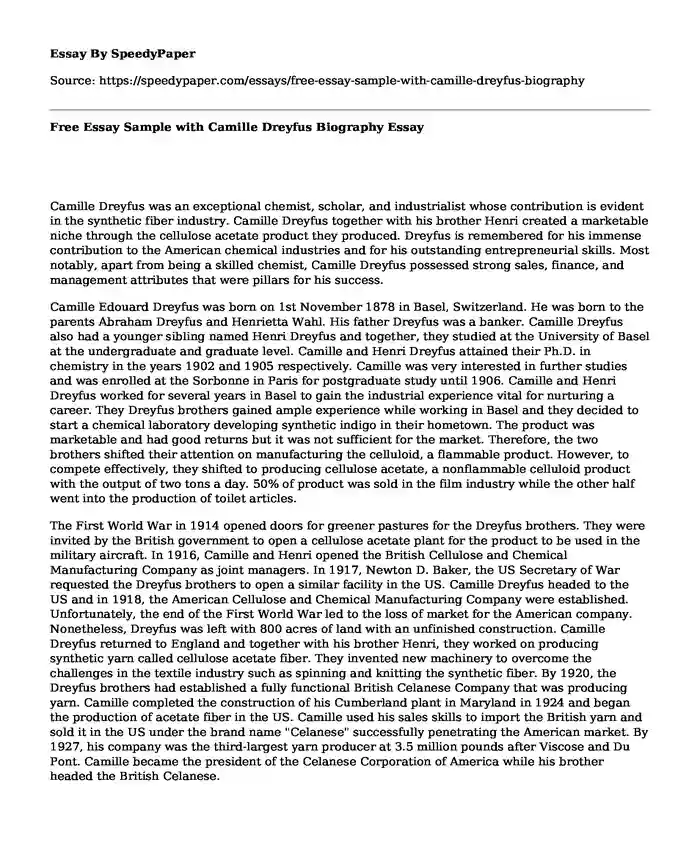Camille Dreyfus was an exceptional chemist, scholar, and industrialist whose contribution is evident in the synthetic fiber industry. Camille Dreyfus together with his brother Henri created a marketable niche through the cellulose acetate product they produced. Dreyfus is remembered for his immense contribution to the American chemical industries and for his outstanding entrepreneurial skills. Most notably, apart from being a skilled chemist, Camille Dreyfus possessed strong sales, finance, and management attributes that were pillars for his success.
Camille Edouard Dreyfus was born on 1st November 1878 in Basel, Switzerland. He was born to the parents Abraham Dreyfus and Henrietta Wahl. His father Dreyfus was a banker. Camille Dreyfus also had a younger sibling named Henri Dreyfus and together, they studied at the University of Basel at the undergraduate and graduate level. Camille and Henri Dreyfus attained their Ph.D. in chemistry in the years 1902 and 1905 respectively. Camille was very interested in further studies and was enrolled at the Sorbonne in Paris for postgraduate study until 1906. Camille and Henri Dreyfus worked for several years in Basel to gain the industrial experience vital for nurturing a career. They Dreyfus brothers gained ample experience while working in Basel and they decided to start a chemical laboratory developing synthetic indigo in their hometown. The product was marketable and had good returns but it was not sufficient for the market. Therefore, the two brothers shifted their attention on manufacturing the celluloid, a flammable product. However, to compete effectively, they shifted to producing cellulose acetate, a nonflammable celluloid product with the output of two tons a day. 50% of product was sold in the film industry while the other half went into the production of toilet articles.
The First World War in 1914 opened doors for greener pastures for the Dreyfus brothers. They were invited by the British government to open a cellulose acetate plant for the product to be used in the military aircraft. In 1916, Camille and Henri opened the British Cellulose and Chemical Manufacturing Company as joint managers. In 1917, Newton D. Baker, the US Secretary of War requested the Dreyfus brothers to open a similar facility in the US. Camille Dreyfus headed to the US and in 1918, the American Cellulose and Chemical Manufacturing Company were established. Unfortunately, the end of the First World War led to the loss of market for the American company. Nonetheless, Dreyfus was left with 800 acres of land with an unfinished construction. Camille Dreyfus returned to England and together with his brother Henri, they worked on producing synthetic yarn called cellulose acetate fiber. They invented new machinery to overcome the challenges in the textile industry such as spinning and knitting the synthetic fiber. By 1920, the Dreyfus brothers had established a fully functional British Celanese Company that was producing yarn. Camille completed the construction of his Cumberland plant in Maryland in 1924 and began the production of acetate fiber in the US. Camille used his sales skills to import the British yarn and sold it in the US under the brand name "Celanese" successfully penetrating the American market. By 1927, his company was the third-largest yarn producer at 3.5 million pounds after Viscose and Du Pont. Camille became the president of the Celanese Corporation of America while his brother headed the British Celanese.
Camille Dreyfus was also a family man and married Jean Tennyson in 1931 and the couple had no children. His wife was a radio singer. Camille expanded his company in the US and in particular, the Second World War profited the Cellulose Corporation that had acquired the Celluloid Corporation. In 1945, Camille became the chairman of the Cellulose Corporation board where he remained as an executive member until his death on 27th September 1956 in New York.
In conclusion, Camille Dreyfus was a successful chemist, industrialist, and entrepreneur. By the 1940's, he had registered 230 patents in the US. Camille and Henri Dreyfus are a proof that family companies can be successfully coupled with the right leadership.
Bibliography
Britannica, The Editors of Encyclopaedia. "Cellulose Acetate." Encyclopaedia Britannica.
July 22, 2009. Accessed May 30, 2018. https://www.britannica.com/science/cellulose-acetate#ref1052602.
Cutcliffe, Stephen H. "Dreyfus, Camille Edouard (1878-1956), Industrial Chemist and Entrepreneur." American National Biography Online, 2000. Doi:10.1093/anb/9780198606697.article.1302160 (Accessed May 30, 2018).
Dameshek, W. "Dr. Camille Dreyfus." Blood 29, no. 6 (July 1967): 932-3. Accessed May 30, 2018. Worldcat.org.
Haller, Charles R. "Dreyfus. Camille Edouard Dreyfus (1878-1956)." German-American Business Biographies: High Finance and Big Business. Accessed May 30, 2018. Worldcat.org.
Raber, Linda. "Camille & Henry Dreyfus Foundation Names Mark Cardillo As Executive Director." Chemical & Engineering News Archive 81, no. 10 (2003). Doi:10.1021/cen-v081n010.p014a.
The Camille & Henry Dreyfus Foundation Inc. 2018. "History". Dreyfus.Org. http://www.dreyfus.org/about/history.shtml.
Cite this page
Free Essay Sample with Camille Dreyfus Biography. (2022, Jun 06). Retrieved from https://speedypaper.net/essays/free-essay-sample-with-camille-dreyfus-biography
Request Removal
If you are the original author of this essay and no longer wish to have it published on the SpeedyPaper website, please click below to request its removal:
- Free Essay Sample on Life Work Balance
- Acid Base Balance Essay Example
- Essay Sample Comprising the Nutrition Journal
- Free Essay on Analysis of the Second Treatise of Government by John Locke
- Free Essay. Centerville Chemical Explosion
- Paper Example: Dyslexia
- Essay Sample on The Verve: Bittersweet Symphony
Popular categories





